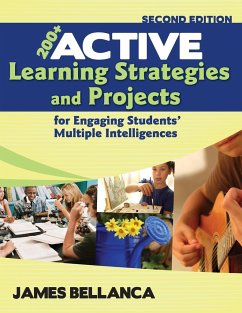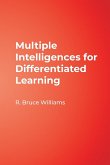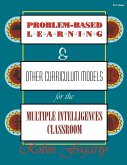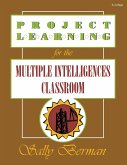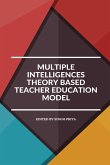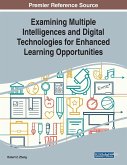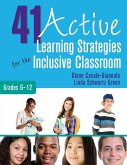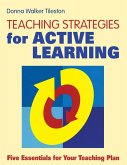James Bellanca
200+ Active Learning Strategies and Projects for Engaging Students' Multiple Intelligences
James Bellanca
200+ Active Learning Strategies and Projects for Engaging Students' Multiple Intelligences
- Broschiertes Buch
- Merkliste
- Auf die Merkliste
- Bewerten Bewerten
- Teilen
- Produkt teilen
- Produkterinnerung
- Produkterinnerung
Organized by intelligence area, this resource provides more than 200 new and enhanced strategies to help teachers increase students' motivation and transform them into active learners.
Andere Kunden interessierten sich auch für
![Multiple Intelligences for Differentiated Learning Multiple Intelligences for Differentiated Learning]() R Bruce WilliamsMultiple Intelligences for Differentiated Learning27,99 €
R Bruce WilliamsMultiple Intelligences for Differentiated Learning27,99 €![Problem-Based Learning & Other Curriculum Models for the Multiple Intelligences Classroom Problem-Based Learning & Other Curriculum Models for the Multiple Intelligences Classroom]() Robin J FogartyProblem-Based Learning & Other Curriculum Models for the Multiple Intelligences Classroom40,99 €
Robin J FogartyProblem-Based Learning & Other Curriculum Models for the Multiple Intelligences Classroom40,99 €![Project Learning for the Multiple Intelligences Classroom Project Learning for the Multiple Intelligences Classroom]() Sally BermanProject Learning for the Multiple Intelligences Classroom40,99 €
Sally BermanProject Learning for the Multiple Intelligences Classroom40,99 €![Multiple intelligences theory based teacher education model Multiple intelligences theory based teacher education model]() Singh PriyaMultiple intelligences theory based teacher education model30,99 €
Singh PriyaMultiple intelligences theory based teacher education model30,99 €![Examining Multiple Intelligences and Digital Technologies for Enhanced Learning Opportunities Examining Multiple Intelligences and Digital Technologies for Enhanced Learning Opportunities]() Examining Multiple Intelligences and Digital Technologies for Enhanced Learning Opportunities176,99 €
Examining Multiple Intelligences and Digital Technologies for Enhanced Learning Opportunities176,99 €![41 Active Learning Strategies for the Inclusive Classroom, Grades 6-12 41 Active Learning Strategies for the Inclusive Classroom, Grades 6-12]() Diane Giannola41 Active Learning Strategies for the Inclusive Classroom, Grades 6-1241,99 €
Diane Giannola41 Active Learning Strategies for the Inclusive Classroom, Grades 6-1241,99 €![Teaching Strategies for Active Learning Teaching Strategies for Active Learning]() Donna Walker TilestonTeaching Strategies for Active Learning31,99 €
Donna Walker TilestonTeaching Strategies for Active Learning31,99 €-
-
-
Organized by intelligence area, this resource provides more than 200 new and enhanced strategies to help teachers increase students' motivation and transform them into active learners.
Hinweis: Dieser Artikel kann nur an eine deutsche Lieferadresse ausgeliefert werden.
Hinweis: Dieser Artikel kann nur an eine deutsche Lieferadresse ausgeliefert werden.
Produktdetails
- Produktdetails
- Verlag: Corwin
- 2. Auflage
- Seitenzahl: 368
- Erscheinungstermin: 11. November 2008
- Englisch
- Abmessung: 280mm x 216mm x 20mm
- Gewicht: 925g
- ISBN-13: 9781412968850
- ISBN-10: 1412968852
- Artikelnr.: 25053529
- Herstellerkennzeichnung
- Libri GmbH
- Europaallee 1
- 36244 Bad Hersfeld
- gpsr@libri.de
- Verlag: Corwin
- 2. Auflage
- Seitenzahl: 368
- Erscheinungstermin: 11. November 2008
- Englisch
- Abmessung: 280mm x 216mm x 20mm
- Gewicht: 925g
- ISBN-13: 9781412968850
- ISBN-10: 1412968852
- Artikelnr.: 25053529
- Herstellerkennzeichnung
- Libri GmbH
- Europaallee 1
- 36244 Bad Hersfeld
- gpsr@libri.de
James Bellanca is a life-long advocate for the principles and practices created by Reuven Feuerstein. As a Senior Fellow for the Partnership for 21st Century Learning, he created and edits the innovative P21Blogazine. He is the editor of a series of 21st Century Deeper Learning collections, has authored more than a dozen how-to books aimed to infuse critical and creative thinking across the curriculum and is President of the Illinois Consortium for 21st Century Schools.
Part I. Preface to the Second Edition
Part II. Acknowledgments
Part III. About the Author
Part IV. Introduction
1. Part I: Verbal/Linguistic Intelligence
1. The Vocabulary Bank
2. What's It All About?
3. Issue Editorial
4. The Big Picture: A Textbook Walk-Through
5. Bag of Knowledge
6. Question Web
7. Explain Why
8. What It Looks Like
9. Lead-In Statements
10. Carousel
11. Letter to the Editor
12. Pointed Paragraphs
13. Democratic Dots
14. Goldfish Bowl
15. Rank Order Ladder
16. Exemplary Examples
17. Three-Legged Stool
18. Concept Connections
19. Newspaper Graphic
20. Story Tree
21. Class Magazine: A Project
22. Interviewing
23. TV News Flash
24. Round-Robin Response in Turn
25. Solve a Story Problem
2. Part II: Logical/Mathematical Intelligence
26. Way to Go! A Rubric
27. People Search
28. Math Jigsaw
29. Sequence Chart
30. Paired-Partner Problem Solving
31. Pizza Pizza
32. Understanding Circles
33. Number Survey
34. Scale It
35. Pie Chart
36. Recipe Magic
37. Collect, Count, and Classify
38. Patterns
39. Stock Exchange
40. Measure My Garden
41. Problem-Solving Strategy Wheel
42. Treasure Map
43. Check for Understanding: A Tool for Differentiating Instruction
44. The Fishbone Chart
45. Go Figure
46. Math Career Collage
47. Logic Organizers
48. The Magic Mediator
49. Getting the Big Idea
50. Hypothesis Test
51. Gallery Walk
3. Part III: Visual/Spatial Intelligence
52. Hourglass Graphic
53. Concept Connections
54. KWL: A Prior Knowledge Check
55. Web Check
56. Learning Links
57. Create an Ad
58. We-Know Parachute
59. Mindful Mobile
60. Topical Museum
61. Make a Poster
62. Make a Graph
63. Nonsensical Creations Outside the Box
64. Design a Machine
65. Picture Vocabulary
66. Working With Venn Diagrams
67. Map Making
68. Create a Collage
69. Model Building
70. PowerPoint Reports
71. Storyboard Concepts
72. Snapshot Sequence Chart
73. Cartoon Stories
74. Symbolic Sense
75. Write a Card
76. Visual Journals
4. Part IV: Bodily/Kinesthetic Intelligence
77. Healthy Helpers
78. Pantomime Pals
79. Stretch Goal
80. Take a Hike
81. Warm Up, Cool Down
82. Silly Walk
83. Shadow Play
84. Posture Popcorn Party
85. Monthly Dancercise
86. Build a Tower
87. Pattern Dances
88. Playground Races
89. Who Is in My Zoo?
90. Juggle Challenge
91. Team Cheers
92. Interpretive Role-Play
93. Human Graph
94. Class Reunion Name Tags
95. Silent Hurrahs
96. Four Corners
97. Concept Treasure Hunt
98. Team Play
99. Teamwork Collage
100. Pass the Baton
101. Vocabulary Basketball
5. Part V. Musical/Rhythmic Intelligence
102. Recall Rap
103. Assessment Rap
104. Sing a Song to Remember
105. Music Connector
106. Play It
107. Instrument Inventor
108. Rhythms to Recall
109. Listening Time
110. Concert Trip
111. Musical Styles
112. Musical Volunteers
113. Magic in Music
114. Group Song
115. Group Cheer
116. Song of the Week
117. Musical Review
118. Rap It Up: A Summarizing Task
119. Sounds of Culture
120. Rhyme Words
121. Name Poem
122. Haiku
123. Sonnets
124. Rhyme Stories
125. Humdinger
126. The Sounds in Words
6. Part VI: Interpersonal Intelligence
127. Our Common Goal
128. Forming Cooperative Groups
129. Group Goal
130. Team Banner Ad
131. Group Logo
132. Group Cheers and Songs
133. Group Ad
134. Three Questions Plus One
135. Jigsaw
136. Expert Jigsaw
137. Coach a Partner
138. Cooperative Guidelines
139. Social Skill T-Chart
140. Cooperative Roles
141. Base Groups
142. Internet Friends
143. Three-to-One Synthesis
144. Internet Investigations
145. Forming Mixed-Ability Groups
146. Group Motto
147. 2-4-8 Classroom Learning Community
148. Pair-Shares
149. High Jump
150. Group-Assessment Cards
151. Getting It Straight
7. Part VII: Intrapersonal Intelligence
152. Quiet Time
153. Daily Journal Lead-In Statements
154. Target
155. One-Minute Mirror
156. Self-Progress Chart
157. Strong Summary Statement
158. Plus/Minus/Interesting (PMI) Assessment
159. My Goals
160. Self-Talk
161. Self-Review
162. My Problem
163. It's My Call
164. Standards of Excellence
165. Portfolio
166. Life Timeline
167. People Influences
168. Career Ladder
169. Seasonal Letter
170. Goal Chart
171. Plus or Minus
172. Autobiography
173. Decision Letter
174. School Support Letter
175. Internet Hobby Search
176. Mrs. Potter's Questions
8. Part VIII: Naturalist Intelligence
177. Green Garden Classroom: A Project
178. Observation Sketches
179. Classification Matrix
180. Plant Observation Project
181. What Is the Problem?
182. Science Interview
183. Aha! Log
184. Comparing Phenomena
185. Science News
186. Prediction Check
187. Internship in Science
188. Nature Directions
189. Cause and Effect
190. Science Exhibition
191. Science Yearbook
192. Bubble Talk
193. Discovery Game
194. Futuristic Science Fair
195. Nature Rubbings
196. Window to the World: A Mural
197. Scientific Scenario
198. Visual Record
199. Just Collect It
200. Agree/Disagree Issues
201. The Issue Investigator
Part V. Resource A: Designing Active Learning Lessons and Projects
Part VI. Resource B: Blacklines
Part VII. Resource C: Glossary
Part VIII. Bibliography
Part IX. Index
Part II. Acknowledgments
Part III. About the Author
Part IV. Introduction
1. Part I: Verbal/Linguistic Intelligence
1. The Vocabulary Bank
2. What's It All About?
3. Issue Editorial
4. The Big Picture: A Textbook Walk-Through
5. Bag of Knowledge
6. Question Web
7. Explain Why
8. What It Looks Like
9. Lead-In Statements
10. Carousel
11. Letter to the Editor
12. Pointed Paragraphs
13. Democratic Dots
14. Goldfish Bowl
15. Rank Order Ladder
16. Exemplary Examples
17. Three-Legged Stool
18. Concept Connections
19. Newspaper Graphic
20. Story Tree
21. Class Magazine: A Project
22. Interviewing
23. TV News Flash
24. Round-Robin Response in Turn
25. Solve a Story Problem
2. Part II: Logical/Mathematical Intelligence
26. Way to Go! A Rubric
27. People Search
28. Math Jigsaw
29. Sequence Chart
30. Paired-Partner Problem Solving
31. Pizza Pizza
32. Understanding Circles
33. Number Survey
34. Scale It
35. Pie Chart
36. Recipe Magic
37. Collect, Count, and Classify
38. Patterns
39. Stock Exchange
40. Measure My Garden
41. Problem-Solving Strategy Wheel
42. Treasure Map
43. Check for Understanding: A Tool for Differentiating Instruction
44. The Fishbone Chart
45. Go Figure
46. Math Career Collage
47. Logic Organizers
48. The Magic Mediator
49. Getting the Big Idea
50. Hypothesis Test
51. Gallery Walk
3. Part III: Visual/Spatial Intelligence
52. Hourglass Graphic
53. Concept Connections
54. KWL: A Prior Knowledge Check
55. Web Check
56. Learning Links
57. Create an Ad
58. We-Know Parachute
59. Mindful Mobile
60. Topical Museum
61. Make a Poster
62. Make a Graph
63. Nonsensical Creations Outside the Box
64. Design a Machine
65. Picture Vocabulary
66. Working With Venn Diagrams
67. Map Making
68. Create a Collage
69. Model Building
70. PowerPoint Reports
71. Storyboard Concepts
72. Snapshot Sequence Chart
73. Cartoon Stories
74. Symbolic Sense
75. Write a Card
76. Visual Journals
4. Part IV: Bodily/Kinesthetic Intelligence
77. Healthy Helpers
78. Pantomime Pals
79. Stretch Goal
80. Take a Hike
81. Warm Up, Cool Down
82. Silly Walk
83. Shadow Play
84. Posture Popcorn Party
85. Monthly Dancercise
86. Build a Tower
87. Pattern Dances
88. Playground Races
89. Who Is in My Zoo?
90. Juggle Challenge
91. Team Cheers
92. Interpretive Role-Play
93. Human Graph
94. Class Reunion Name Tags
95. Silent Hurrahs
96. Four Corners
97. Concept Treasure Hunt
98. Team Play
99. Teamwork Collage
100. Pass the Baton
101. Vocabulary Basketball
5. Part V. Musical/Rhythmic Intelligence
102. Recall Rap
103. Assessment Rap
104. Sing a Song to Remember
105. Music Connector
106. Play It
107. Instrument Inventor
108. Rhythms to Recall
109. Listening Time
110. Concert Trip
111. Musical Styles
112. Musical Volunteers
113. Magic in Music
114. Group Song
115. Group Cheer
116. Song of the Week
117. Musical Review
118. Rap It Up: A Summarizing Task
119. Sounds of Culture
120. Rhyme Words
121. Name Poem
122. Haiku
123. Sonnets
124. Rhyme Stories
125. Humdinger
126. The Sounds in Words
6. Part VI: Interpersonal Intelligence
127. Our Common Goal
128. Forming Cooperative Groups
129. Group Goal
130. Team Banner Ad
131. Group Logo
132. Group Cheers and Songs
133. Group Ad
134. Three Questions Plus One
135. Jigsaw
136. Expert Jigsaw
137. Coach a Partner
138. Cooperative Guidelines
139. Social Skill T-Chart
140. Cooperative Roles
141. Base Groups
142. Internet Friends
143. Three-to-One Synthesis
144. Internet Investigations
145. Forming Mixed-Ability Groups
146. Group Motto
147. 2-4-8 Classroom Learning Community
148. Pair-Shares
149. High Jump
150. Group-Assessment Cards
151. Getting It Straight
7. Part VII: Intrapersonal Intelligence
152. Quiet Time
153. Daily Journal Lead-In Statements
154. Target
155. One-Minute Mirror
156. Self-Progress Chart
157. Strong Summary Statement
158. Plus/Minus/Interesting (PMI) Assessment
159. My Goals
160. Self-Talk
161. Self-Review
162. My Problem
163. It's My Call
164. Standards of Excellence
165. Portfolio
166. Life Timeline
167. People Influences
168. Career Ladder
169. Seasonal Letter
170. Goal Chart
171. Plus or Minus
172. Autobiography
173. Decision Letter
174. School Support Letter
175. Internet Hobby Search
176. Mrs. Potter's Questions
8. Part VIII: Naturalist Intelligence
177. Green Garden Classroom: A Project
178. Observation Sketches
179. Classification Matrix
180. Plant Observation Project
181. What Is the Problem?
182. Science Interview
183. Aha! Log
184. Comparing Phenomena
185. Science News
186. Prediction Check
187. Internship in Science
188. Nature Directions
189. Cause and Effect
190. Science Exhibition
191. Science Yearbook
192. Bubble Talk
193. Discovery Game
194. Futuristic Science Fair
195. Nature Rubbings
196. Window to the World: A Mural
197. Scientific Scenario
198. Visual Record
199. Just Collect It
200. Agree/Disagree Issues
201. The Issue Investigator
Part V. Resource A: Designing Active Learning Lessons and Projects
Part VI. Resource B: Blacklines
Part VII. Resource C: Glossary
Part VIII. Bibliography
Part IX. Index
Part I. Preface to the Second Edition
Part II. Acknowledgments
Part III. About the Author
Part IV. Introduction
1. Part I: Verbal/Linguistic Intelligence
1. The Vocabulary Bank
2. What's It All About?
3. Issue Editorial
4. The Big Picture: A Textbook Walk-Through
5. Bag of Knowledge
6. Question Web
7. Explain Why
8. What It Looks Like
9. Lead-In Statements
10. Carousel
11. Letter to the Editor
12. Pointed Paragraphs
13. Democratic Dots
14. Goldfish Bowl
15. Rank Order Ladder
16. Exemplary Examples
17. Three-Legged Stool
18. Concept Connections
19. Newspaper Graphic
20. Story Tree
21. Class Magazine: A Project
22. Interviewing
23. TV News Flash
24. Round-Robin Response in Turn
25. Solve a Story Problem
2. Part II: Logical/Mathematical Intelligence
26. Way to Go! A Rubric
27. People Search
28. Math Jigsaw
29. Sequence Chart
30. Paired-Partner Problem Solving
31. Pizza Pizza
32. Understanding Circles
33. Number Survey
34. Scale It
35. Pie Chart
36. Recipe Magic
37. Collect, Count, and Classify
38. Patterns
39. Stock Exchange
40. Measure My Garden
41. Problem-Solving Strategy Wheel
42. Treasure Map
43. Check for Understanding: A Tool for Differentiating Instruction
44. The Fishbone Chart
45. Go Figure
46. Math Career Collage
47. Logic Organizers
48. The Magic Mediator
49. Getting the Big Idea
50. Hypothesis Test
51. Gallery Walk
3. Part III: Visual/Spatial Intelligence
52. Hourglass Graphic
53. Concept Connections
54. KWL: A Prior Knowledge Check
55. Web Check
56. Learning Links
57. Create an Ad
58. We-Know Parachute
59. Mindful Mobile
60. Topical Museum
61. Make a Poster
62. Make a Graph
63. Nonsensical Creations Outside the Box
64. Design a Machine
65. Picture Vocabulary
66. Working With Venn Diagrams
67. Map Making
68. Create a Collage
69. Model Building
70. PowerPoint Reports
71. Storyboard Concepts
72. Snapshot Sequence Chart
73. Cartoon Stories
74. Symbolic Sense
75. Write a Card
76. Visual Journals
4. Part IV: Bodily/Kinesthetic Intelligence
77. Healthy Helpers
78. Pantomime Pals
79. Stretch Goal
80. Take a Hike
81. Warm Up, Cool Down
82. Silly Walk
83. Shadow Play
84. Posture Popcorn Party
85. Monthly Dancercise
86. Build a Tower
87. Pattern Dances
88. Playground Races
89. Who Is in My Zoo?
90. Juggle Challenge
91. Team Cheers
92. Interpretive Role-Play
93. Human Graph
94. Class Reunion Name Tags
95. Silent Hurrahs
96. Four Corners
97. Concept Treasure Hunt
98. Team Play
99. Teamwork Collage
100. Pass the Baton
101. Vocabulary Basketball
5. Part V. Musical/Rhythmic Intelligence
102. Recall Rap
103. Assessment Rap
104. Sing a Song to Remember
105. Music Connector
106. Play It
107. Instrument Inventor
108. Rhythms to Recall
109. Listening Time
110. Concert Trip
111. Musical Styles
112. Musical Volunteers
113. Magic in Music
114. Group Song
115. Group Cheer
116. Song of the Week
117. Musical Review
118. Rap It Up: A Summarizing Task
119. Sounds of Culture
120. Rhyme Words
121. Name Poem
122. Haiku
123. Sonnets
124. Rhyme Stories
125. Humdinger
126. The Sounds in Words
6. Part VI: Interpersonal Intelligence
127. Our Common Goal
128. Forming Cooperative Groups
129. Group Goal
130. Team Banner Ad
131. Group Logo
132. Group Cheers and Songs
133. Group Ad
134. Three Questions Plus One
135. Jigsaw
136. Expert Jigsaw
137. Coach a Partner
138. Cooperative Guidelines
139. Social Skill T-Chart
140. Cooperative Roles
141. Base Groups
142. Internet Friends
143. Three-to-One Synthesis
144. Internet Investigations
145. Forming Mixed-Ability Groups
146. Group Motto
147. 2-4-8 Classroom Learning Community
148. Pair-Shares
149. High Jump
150. Group-Assessment Cards
151. Getting It Straight
7. Part VII: Intrapersonal Intelligence
152. Quiet Time
153. Daily Journal Lead-In Statements
154. Target
155. One-Minute Mirror
156. Self-Progress Chart
157. Strong Summary Statement
158. Plus/Minus/Interesting (PMI) Assessment
159. My Goals
160. Self-Talk
161. Self-Review
162. My Problem
163. It's My Call
164. Standards of Excellence
165. Portfolio
166. Life Timeline
167. People Influences
168. Career Ladder
169. Seasonal Letter
170. Goal Chart
171. Plus or Minus
172. Autobiography
173. Decision Letter
174. School Support Letter
175. Internet Hobby Search
176. Mrs. Potter's Questions
8. Part VIII: Naturalist Intelligence
177. Green Garden Classroom: A Project
178. Observation Sketches
179. Classification Matrix
180. Plant Observation Project
181. What Is the Problem?
182. Science Interview
183. Aha! Log
184. Comparing Phenomena
185. Science News
186. Prediction Check
187. Internship in Science
188. Nature Directions
189. Cause and Effect
190. Science Exhibition
191. Science Yearbook
192. Bubble Talk
193. Discovery Game
194. Futuristic Science Fair
195. Nature Rubbings
196. Window to the World: A Mural
197. Scientific Scenario
198. Visual Record
199. Just Collect It
200. Agree/Disagree Issues
201. The Issue Investigator
Part V. Resource A: Designing Active Learning Lessons and Projects
Part VI. Resource B: Blacklines
Part VII. Resource C: Glossary
Part VIII. Bibliography
Part IX. Index
Part II. Acknowledgments
Part III. About the Author
Part IV. Introduction
1. Part I: Verbal/Linguistic Intelligence
1. The Vocabulary Bank
2. What's It All About?
3. Issue Editorial
4. The Big Picture: A Textbook Walk-Through
5. Bag of Knowledge
6. Question Web
7. Explain Why
8. What It Looks Like
9. Lead-In Statements
10. Carousel
11. Letter to the Editor
12. Pointed Paragraphs
13. Democratic Dots
14. Goldfish Bowl
15. Rank Order Ladder
16. Exemplary Examples
17. Three-Legged Stool
18. Concept Connections
19. Newspaper Graphic
20. Story Tree
21. Class Magazine: A Project
22. Interviewing
23. TV News Flash
24. Round-Robin Response in Turn
25. Solve a Story Problem
2. Part II: Logical/Mathematical Intelligence
26. Way to Go! A Rubric
27. People Search
28. Math Jigsaw
29. Sequence Chart
30. Paired-Partner Problem Solving
31. Pizza Pizza
32. Understanding Circles
33. Number Survey
34. Scale It
35. Pie Chart
36. Recipe Magic
37. Collect, Count, and Classify
38. Patterns
39. Stock Exchange
40. Measure My Garden
41. Problem-Solving Strategy Wheel
42. Treasure Map
43. Check for Understanding: A Tool for Differentiating Instruction
44. The Fishbone Chart
45. Go Figure
46. Math Career Collage
47. Logic Organizers
48. The Magic Mediator
49. Getting the Big Idea
50. Hypothesis Test
51. Gallery Walk
3. Part III: Visual/Spatial Intelligence
52. Hourglass Graphic
53. Concept Connections
54. KWL: A Prior Knowledge Check
55. Web Check
56. Learning Links
57. Create an Ad
58. We-Know Parachute
59. Mindful Mobile
60. Topical Museum
61. Make a Poster
62. Make a Graph
63. Nonsensical Creations Outside the Box
64. Design a Machine
65. Picture Vocabulary
66. Working With Venn Diagrams
67. Map Making
68. Create a Collage
69. Model Building
70. PowerPoint Reports
71. Storyboard Concepts
72. Snapshot Sequence Chart
73. Cartoon Stories
74. Symbolic Sense
75. Write a Card
76. Visual Journals
4. Part IV: Bodily/Kinesthetic Intelligence
77. Healthy Helpers
78. Pantomime Pals
79. Stretch Goal
80. Take a Hike
81. Warm Up, Cool Down
82. Silly Walk
83. Shadow Play
84. Posture Popcorn Party
85. Monthly Dancercise
86. Build a Tower
87. Pattern Dances
88. Playground Races
89. Who Is in My Zoo?
90. Juggle Challenge
91. Team Cheers
92. Interpretive Role-Play
93. Human Graph
94. Class Reunion Name Tags
95. Silent Hurrahs
96. Four Corners
97. Concept Treasure Hunt
98. Team Play
99. Teamwork Collage
100. Pass the Baton
101. Vocabulary Basketball
5. Part V. Musical/Rhythmic Intelligence
102. Recall Rap
103. Assessment Rap
104. Sing a Song to Remember
105. Music Connector
106. Play It
107. Instrument Inventor
108. Rhythms to Recall
109. Listening Time
110. Concert Trip
111. Musical Styles
112. Musical Volunteers
113. Magic in Music
114. Group Song
115. Group Cheer
116. Song of the Week
117. Musical Review
118. Rap It Up: A Summarizing Task
119. Sounds of Culture
120. Rhyme Words
121. Name Poem
122. Haiku
123. Sonnets
124. Rhyme Stories
125. Humdinger
126. The Sounds in Words
6. Part VI: Interpersonal Intelligence
127. Our Common Goal
128. Forming Cooperative Groups
129. Group Goal
130. Team Banner Ad
131. Group Logo
132. Group Cheers and Songs
133. Group Ad
134. Three Questions Plus One
135. Jigsaw
136. Expert Jigsaw
137. Coach a Partner
138. Cooperative Guidelines
139. Social Skill T-Chart
140. Cooperative Roles
141. Base Groups
142. Internet Friends
143. Three-to-One Synthesis
144. Internet Investigations
145. Forming Mixed-Ability Groups
146. Group Motto
147. 2-4-8 Classroom Learning Community
148. Pair-Shares
149. High Jump
150. Group-Assessment Cards
151. Getting It Straight
7. Part VII: Intrapersonal Intelligence
152. Quiet Time
153. Daily Journal Lead-In Statements
154. Target
155. One-Minute Mirror
156. Self-Progress Chart
157. Strong Summary Statement
158. Plus/Minus/Interesting (PMI) Assessment
159. My Goals
160. Self-Talk
161. Self-Review
162. My Problem
163. It's My Call
164. Standards of Excellence
165. Portfolio
166. Life Timeline
167. People Influences
168. Career Ladder
169. Seasonal Letter
170. Goal Chart
171. Plus or Minus
172. Autobiography
173. Decision Letter
174. School Support Letter
175. Internet Hobby Search
176. Mrs. Potter's Questions
8. Part VIII: Naturalist Intelligence
177. Green Garden Classroom: A Project
178. Observation Sketches
179. Classification Matrix
180. Plant Observation Project
181. What Is the Problem?
182. Science Interview
183. Aha! Log
184. Comparing Phenomena
185. Science News
186. Prediction Check
187. Internship in Science
188. Nature Directions
189. Cause and Effect
190. Science Exhibition
191. Science Yearbook
192. Bubble Talk
193. Discovery Game
194. Futuristic Science Fair
195. Nature Rubbings
196. Window to the World: A Mural
197. Scientific Scenario
198. Visual Record
199. Just Collect It
200. Agree/Disagree Issues
201. The Issue Investigator
Part V. Resource A: Designing Active Learning Lessons and Projects
Part VI. Resource B: Blacklines
Part VII. Resource C: Glossary
Part VIII. Bibliography
Part IX. Index

